In today's world, using a smartphone has become a necessity, even in activities that may expose it to water. Hence, the need for waterproof smartphones capable of withstanding various conditions has emerged.
But do waterproof phones differ from water-resistant ones? And are all water-resistant phones equal in their ability to withstand water?
What is the difference between Water Resistant and waterproof phones?
In this article, we'll delve into the distinction between two phone types and elucidate how to interpret IP ratings for a deeper grasp of your phone's protective level. Furthermore, we'll furnish you with tips to prolong the lifespan of your water-resistant phone.
Primarily, it's crucial to grasp that there are two distinct terms denoting water resistance. Water resistance commonly hinges on material density, dictating the device's capacity to endure water to diverse extents.
Water Resistant
A waterproof phone plays a crucial role in the realm of smart devices, offering protection against moisture and water exposure. Its resilience allows it to endure moderate moisture levels and brief water exposure without compromising performance. For instance, if the phone accidentally encounters rain or a shallow water spill and is promptly retrieved, it can continue functioning normally without harm.
- A property, not an absolute attribute.
- Refers to the phone's ability to withstand exposure to specific amounts of water for a specified period of time.
- This resistance is measured by an IP rating system (international protection) that determines the level of resistance of the phone to dust and water.
- For example, a phone with an IP67 rating that is 100% dustproof and resistant to submersion in water to a depth of 1 meter for 30 minutes.
Nevertheless, it's important to recognize that a waterproof phone isn't intended for prolonged submersion. Despite its resistance to moisture, it's not suitable for activities like diving or extended immersion. Using a waterproof phone judiciously and adhering to the guidelines outlined in the user manual is essential for preserving its performance and preventing potential damage.
Waterproof
In today's technological landscape, mobile phones have transcended their original role as mere communication devices, becoming indispensable companions that accompany us everywhere, even in aquatic environments. The advent of waterproof technology marks a notable progression in this realm, granting us the freedom to use our phones without concern for water-related damage.
- Waterproof phones have a durable and airtight design that prevents water from seeping into the device. This includes the use of waterproof materials and tight sealing of the internal parts to prevent any leakage.
- Waterproof technology allows the phone to be used in a variety of conditions, including outdoor adventures and water activities, without having to worry about damage to the device due to water.
A waterproof phone is a device engineered to endure immersion in water for a defined duration and under specific pressure conditions without sustaining harm. These devices incorporate specialized methodologies to effectively prevent water infiltration, even in challenging circumstances.
The main difference between waterproof and anti-waterproof:
In the world of smartphones, devices are classified as either waterproof or water-resistant. The main difference is their ability to endure liquids overall.
Water Resistant phone:
The waterproof phone has the ability to withstand exposure to certain degrees of moisture or splash without its performance being affected. These devices are usually designed to withstand light water splashes or use in humid environments such as indoor spaces in general.
Waterproof phone:
The waterproof phone goes beyond mere resistance, as it can endure full immersion in water for a set duration, allowing for underwater use without harm. This makes it ideal for activities such as underwater photography or swimming.
With technological advancements, waterproof phones have become essential for keeping pace with our active and varied lifestyles. It's not merely an added feature but rather a necessity to ensure the safety and usability of our devices in diverse and challenging conditions.
Use of the two terms in marketing:
Some companies may use the term "waterproof" in marketing to promote their products, but in reality, there is no real device that can be described as waterproof in the literal sense. Consumers should be careful and read the specifications carefully to understand the device's ability to handle water.
Understanding IP standards
The IP rating consists of two numbers:
the first number:
- Demonstrates dust resistance.
- It ranges from 0 (no resistance) to 6 (complete resistance).
The second number:
- Indicates water resistance.
- It ranges from 0 (no resistance) to 8 (resistant to immersion in water to a depth of 2 m for 30 minutes).
Examples of IP ratings:
- IP68: 100% dustproof and submersible up to 1.5 meters for 30 minutes.
- IPX7: Unspecified dust resistant and resistant to submersion in water to a depth of 1 meter for 30 minutes.
- IP54: 50% dust resistant and splash resistant from all directions.
This is some information about water resistance or waterproof phones and information about IP ratings. I hope you benefit from it.




